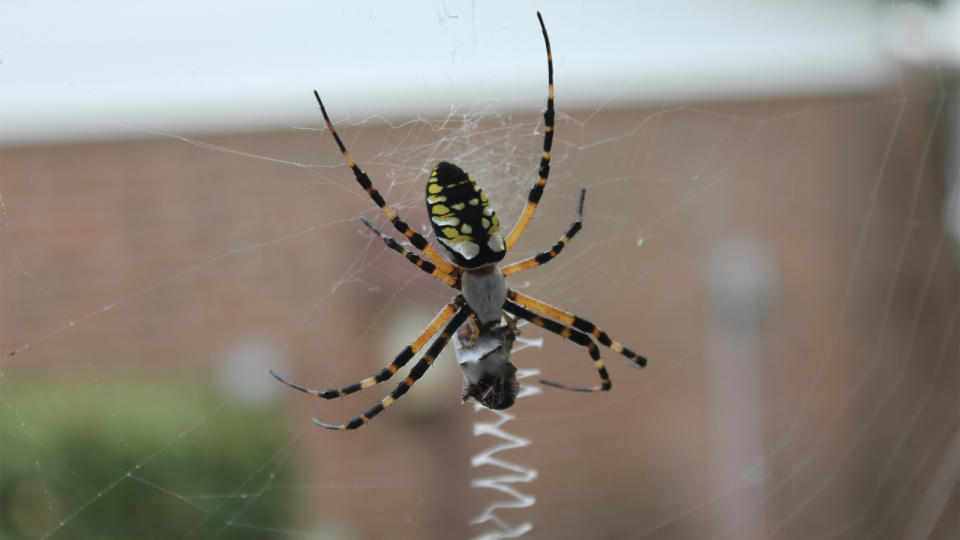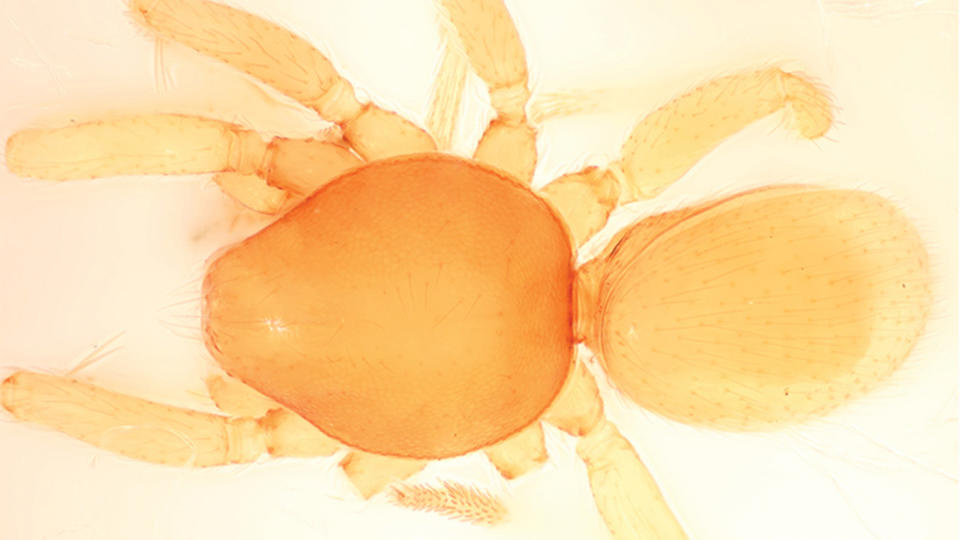Are Banana Spiders Harmless? Depends on Which You See

Have you ever been on a walk with a friend, and you pass a big spider sitting in the center of a web? Maybe you express hefty alarm, but your friend says, "Oh, that? Don't worry, banana spiders are harmless."
While this assurance might be encouraging, it's basically inaccurate. Your friend might, in fact, know for certain that that particular arachnid — black and yellow, sitting in the middle of a giant web that has a zigzag in it that looks as if it's made of dental floss — will not hurt you.
However, it's definitely not true that every species on Earth commonly called a "banana spider" is harmless, so you shouldn't go around spreading that good news. Here is where we run into the problem with common names.
Scientific Naming and Carl Linnaeus
Every life form on this planet that humans "officially" (meaning scientifically) know about — from animals to archaea — has a scientific name. Some of them also have one or 14 common names as well. In the 18th century, a Swedish botanist named Carl Linnaeus developed this process of naming living things.
Linneaus created a double naming convention, and figured out how to organize living things into categories that made sense based on their form, structure and habits. Linneaus was a very organized Swede, and his solution became the standard for scientific taxonomy.
Common Names: Creative but Flawed
The process by which the rest of us collectively come up with common names isn't Linneaan in the least. It often involves one person thinking that spider species over there looks like it has a banana pattern on it and telling their buddies, and before too long, everybody's calling that animal a "banana spider."
It's not a very precise way to name something, but common names have been around much, much longer than scientific names, and we still use them every day. If you went around referring to horses as Equus caballus, people would make fun of you. But sticking to common names can get really confusing really fast.
When you're talking about a black bear, a scientist would want to know whether you were referring to American black bear (Ursus americanus) or the Asian black bear (Ursus thibetanus), two members of the family Ursidae, which live on different continents.
Context can help in figuring out which organism somebody's talking about — if you saw that black bear in Alaska, you could be pretty sure it was the species U. americanus — but not always, especially when you enter the kooky, confusing world of insect and spider taxonomy.
Bugs: A Common Name Free-For-All
"Common names can be tricky because people from different parts of the country or world will use the same common name to describe different species," says Kristie Reddick, founder of The Bug Chicks, an educational company that uses arthropods to teach young people about social issues like prejudice, racism, educational potential and personal development.
"Case in point — the potato bug. Where I'm from in Virginia, the name 'potato bug' refers to an isopod that most people know as a roly-poly. But in the western U.S., 'potato bugs' refer to Jerusalem crickets, which is a kind of ground cricket with big jaws and the head of a demon baby. You can totally hold an isopod, but Jerusalem crickets can bite. Common names can mess up our communication and mess up identification of organisms."
Spider Species: A Case in Point

Trichonephila clavipes (banana spiders) and A. aurantia are often confused for one another. T. clavipes has a slender, cylindrical abdomen, while the mature A. aurantia has a more rounded and somewhat flatter abdomen.
So, back to the banana spider. When your friend says, "Don't freak out, it's just a banana spider," what is she actually talking about? And is she right?
Banana Spider Facts
A few species within the Nephila genus commonly called "banana spiders" are, in fact, harmless. The yellow and black Argiope spiders that can be found all over the contiguous United States (the one that puts a signature zigzag in the middle of their webs) are often called a banana spider or garden spider.
These golden orb weavers usually prefer forest areas where they can cast strong webs to catch flying insects. The forest is also where they lay their eggs. The female spins two or more egg sacs holding hundreds of eggs, onto the sides of trees. You can tell a female banana spider from a male as they are usually larger than the male banana spider.
While it has venom like all spiders, this banana spider bite doesn't cause much of a reaction in healthy adult humans — usually, a slight redness at the bite area and irritation milder than a bee sting.
Also common in North America are spiders with cylindrical bodies that are commonly called banana spiders, golden silk spiders, writing spiders or calico spiders, and their venom is largely harmless to humans as well. However, some species have large fangs, so if they do have occasion to bite you, it might hurt like any other puncture wound.
5 Arachnids Commonly Called Banana Spiders
Not everything we refer to as a "banana spider" is a harmless gentle giant.
1. Brazilian Wandering Spider

"When I think of banana spiders, I think of the Brazilian wandering spider in the genus Phoneutria," says Reddick. "My grandfather was bitten by one when he was a dock worker in New York City. He was unloading bananas from South America when he was bitten. It was apparently so painful that it became a part of our family storytelling legends."
Brazilian wandering spiders, whose name (Phoneutria) comes from the Greek word for "murderess," are extremely toxic, packing enough venom to kill a small child.
Called "banana spiders" because they are often found in banana shipments from the warmer regions in South America and Central America, these hairy, brown arachnids don't build webs like the golden silk orb weaver but instead hunt their prey like little jaguars.
If you're bitten by one (which is unlikely unless you live in South America or are working in the banana import business), it's best to seek medical help ASAP.
2. Giant Wood Spider
Another in the banana spider family is the giant wood spider or Nephila pilipes. These banana spiders are indigenous to a host of Asian countries like China, Japan and India and even found as far south as Australia. The female banana spiders have a broad leg span and can get up to 8 inches (20 cm) wide.
3. Golden Silk Orb Weaver
As mentioned above, the golden silk orb weaver (Trichonephila clavipes) is one of the species most commonly called "banana spiders." In this case, the common name "banana spider" refers to the coloration of the female's legs, which sport yellow, brown and orange bands.
While it can be annoying to walk into one of their giant webs, they will bite only if directly threatened and held, and even then, the bite will cause only mild irritation.
4. Hawaiian Garden Spider
These banana spiders are native to the Western Pacific Ocean islands, including Hawaii.
The Hawaiian garden spider (Argiope appensa) is another species that shows pronounced sexual dimorphism (meaning the females and males have very different body sizes and appearances). The females have yellow and black coloration, and are much larger than the brown-colored males.
5. Goblin Spider, Genus Bannana

And to make things more complicated, the scientific name of one goblin spider genus is Bannana. These are extremely small (around 1 or 2 millimeters in length), live in the leaf litter in the high rainforests of China, and have hardly any eyes.
Scientists are uncertain whether they have much in the way of venom, but it's extremely unlikely you'll ever find out.
Now That's Much Simpler
Occasionally a scientific name is actually the same as the common name, such as Tyrannosaurus rex or T. rex.
The Giant Wood Spider
Another in banana spider family is the giant wood spider or Nephila pilipes. These banana spiders are indigenous to a host of Asian countries like China, Japan and India and even found as far south as Australia. The female spiders have an wide leg span and can get up to 20cm wide.
The Goblin Spider, Genus Bannana
And to make things more complicated, the scientific name of one goblin spider genus is Bannana. These are extremely small (around 1 or 2 millimeters in length), live in the leaf litter in the high rainforests of China, and have hardly any eyes. Scientists are uncertain whether they have much in the way of venom, but it's extremely unlikely you'll ever find out.

But, according to Reddick, your friend who told you not to worry about that spider is probably right in one way:
"I think no matter what, it's important to understand that spiders — banana or not — are not out to get you."
And it's fine to use common names — it's just important to clarify and explain exactly what you're talking about if there is any danger of confusion.
Now That's Interesting
Occasionally a scientific name is actually the same as the common name — Tyrannosaurus rex is an example.
Original article: Are Banana Spiders Harmless? Depends on Which You See
Copyright © 2024 HowStuffWorks, a division of InfoSpace Holdings, LLC, a System1 Company


